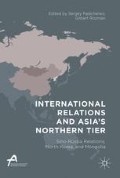Abstract
In 2009, a vast program for cooperation between the Russian Far East and Eastern Siberia, and Northeast China, extending to 2018, was adopted, but it failed due to: negative public sentiments, inflexible Russian bureaucracy, unwritten conditions for not allowing Chinese business into strategic sectors, and the low attractiveness of the Russian Far East for Chinese investors. By 2015, “convergence” of the Silk Road Economic Belt and Eurasian Economic Union was stressed. Russians again are skeptical. Chinese investments are directed at small- and middle-sized enterprises, agriculture, construction, and services, often violating migration and environmental legislation. Chinese investors would like to bring Chinese equipment into Russia tariff-free, to utilize unlimited numbers of Chinese workers, and to lessen control by law enforcement organs. These conditions are rejected, but steps toward a positive scenario are identified.
Access this chapter
Tax calculation will be finalised at checkout
Purchases are for personal use only
Notes
- 1.
Nianshen Song, “Northeast Eurasia as Historical Center: Exploration of a Joint Frontier,” The Asia- Pacific Journal 13, no. 1 (November 2, 2015).
- 2.
陆南泉, 推进中俄区域经贸合作若干问题的研究, 黑龙江社会科学, no. 1, 2009.
- 3.
朱显平, 陆南泉, 俄罗斯东部及能源开发与中国的互动合作:中俄国际区域合作与发展学术研讨会论 (Changchun: Changchun chubanshe, 2009).
- 4.
赵传君, 创建中俄自由贸易区问题探索 (Beijing: Shehuikexue wenxian chubanshe, 2010).
- 5.
Zhang Keyun and Cai Zhibing, “Globalization 4.0, Regional Coordinated Development 4.0, and Industry 4.0: The background to the ‘One Belt, One Road’ strategy and its intrinsic nature and critical power,” ERINA Report, no. 127 (December 2015), http://www.erina.or.jp/wp-content/uploads/2015/02/se12719_tssc.pdf.
- 6.
Li Xin, “Silk Road can find common ground with Eurasian Economic Union,” Global Times, April 26, 2015.
- 7.
Towards the Great Ocean 4: Turn to the East: Preliminary Result and New Objectives (Valdai Discussion Club Report, Moscow, June 2, 2016), http://valdaiclub.com/files/10920/, 17–22.
- 8.
Additional information on Access Meeting China-Russia: Annual Investment Road Show can be found at: http://www.cn888ru.com/cn.
- 9.
Gaye Christoffersen, “The Sino-Russian Partnership in the Asia-Pacific,” Russian International Affairs Council, September 19, 2013, http://russiancouncil.ru/en/blogs/dvfu/?id_4=693.
- 10.
“Why does Japan fear close Sino-Russian ties?” Global Times, June 12, 2016, http://www.globaltimes.cn/content/987736.shtml.
- 11.
United Nations Development Program, National Human Development Report for the Russian Federation 2013 (Moscow: 2013).
- 12.
Ksenia Zubacheva, “Re-thinking Russia’s pivot to China,” Russia Direct, June 2, 2016, http://www.russia-direct.org/analysis/re-thinking-russias-pivot-china.
- 13.
Alexander Gabuev and Vita Spivak, “Perenosstrakhov: stoit li opasat’sia Kitaiskikh zavodov na Dal’nem Vostoke?” Moscow Carnegie Center, http://carnegie.ru/commentary/2016/05/12/ru-63550/iy6s.
- 14.
“Russian Far East witnesses an investment boom—officials,” Russia Beyond the Headlines, May 6, 2016, http://rbth.com/business/2016/05/06/russian-far-east-witnesses-an-investment-boom-officials_590989.
- 15.
A. K. Ordabaev, Geopolitika transportnykh koridorov v Tsentral’noi Azii (Astana-Almaty, 2015), 9.
- 16.
For details see: I. Zuenko, “Is Russia losing its logistics edge?” Moscow Carnegie Center, http://carnegie.ru/commentary/2016/05/10/is-russia-losing-its-logistics-edge/iy5b.
- 17.
“各路中欧班列靠政府补贴艰难维生 几乎全线亏损,” Huanqiuwang, September 2015, http://finance.huanqiu.com/roll/2015-09/7552303.html.
- 18.
A. Gabuev, “Medved’ na sene: chem opasna sdacha v arendu Kitaiu zemli Russkoi,” Moscow Carnegie Center, http://carnegie.ru/2015/06/22/ru-60453/ijsb.
- 19.
V. L Larin and L.L. Larin, “Vostochnaia Aziia v obshchestvennom mnenii Tikhookeanskoi Rossii (po itogam oprosa 2013),” Rossiia i ATR, no. 2 (2014): 5–19.
Author information
Authors and Affiliations
Editor information
Editors and Affiliations
Rights and permissions
Copyright information
© 2018 The Author(s)
About this chapter
Cite this chapter
Christoffersen, G., Zuenko, I. (2018). Northeast China and the Russian Far East: Positive Scenarios and Negative Scenarios. In: Rozman, G., Radchenko, S. (eds) International Relations and Asia’s Northern Tier. Asan-Palgrave Macmillan Series. Palgrave, Singapore. https://doi.org/10.1007/978-981-10-3144-1_13
Download citation
DOI: https://doi.org/10.1007/978-981-10-3144-1_13
Published:
Publisher Name: Palgrave, Singapore
Print ISBN: 978-981-10-3143-4
Online ISBN: 978-981-10-3144-1
eBook Packages: Political Science and International StudiesPolitical Science and International Studies (R0)

